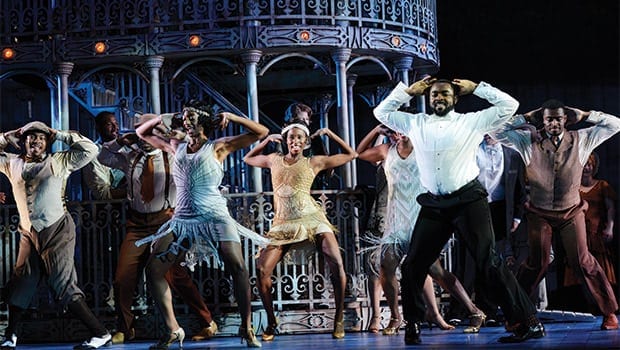
Fiddlehead Theatre Company makes a bold, risky move in reviving the 1927 musical classic “Show Boat” for a contemporary audience. Playing through July 3 at the Shubert Theatre, the three-hour-long show is a mammoth, and at times racially negligent, endeavor. The cast is a talented group and delivers the out-of-date classic with power, precision and showmanship.
Fiddlehead’s cast includes several powerhouse singers. Brian Kinnard, as Joe, belted the classic “Ol’ Man River” with just the right balance of strength and sadness. Jeremiah James, as Gaynor Ravenal, brought charm to an otherwise unlikeable character with his smooth vocals. Queenie (Lindsay Roberts) is another cast notable, who represented a positive black, female image when she helped the ship captain bring in a crowd by being inclusive to all races. To their credit, co-directors Meg Fofonoff and Stacey Stephens did make alterations to the original script to keep from vilifying the black characters.
The score alternated between vibrant numbers like “Can’t Help Lovin’ Dat Man” and ominous pieces like “Mis’ry’s Comin’ Round.” The spectrum has the ghost of a modern musical narrative, but at a longer length. Many of the songs are repeated and often do not service the plot. That said, the classic numbers have withstood the test of time, and continue to please in this revival.
Adapted from a novel by Jerome Kern and Oscar Hammerstein II, “Show Boat” was the first musical to break away from frivolous entertainment to address more serious content in its narrative. This opened the gateway for contemporary theater. The plot deals with a messy marriage, a single mother, and racial tensions in the segregated South. Unfortunately the once-progressive treatment of these topics comes off now as stale and politically questionable. Magnolia Hawkes, the female lead, is abandoned by her husband and raises their daughter by herself. Yet at the end of the show she welcomes him back with open arms. In the age of self-sufficiency and female empowerment, this falls flat.
The stage setting did wonders for updating the content. The two-story, intricately designed showboat seamlessly morphed the stage from the river to the bustling streets of Chicago. The audience is privy to several views of the boat throughout the show, but it never overpowers the stage, the mark of a well-designed set piece. Projection was used heavily to transform the stage. It was successful in creating otherwise hard to structure scenes like a cathedral, but was occasionally distracting. At times the set was visually striking. During a rehearsal scene a small stage is place between two ends of the ironwork boat. A red velvet valance hangs from the ceiling and an olive chaise lounge sits underneath. The luxurious, textural look has the interior effect of a John Singer Sargent painting.
“Show Boat” is not a bad musical when taken in historical context. It is longer and less subtle than many contemporary performances, but it’s a hallmark of theatrical history. Fiddlehead performed the show with precision and gusto, taking a show marked by its time and making it watchable, and even enjoyable.







